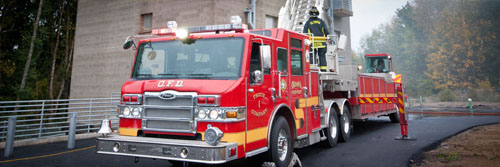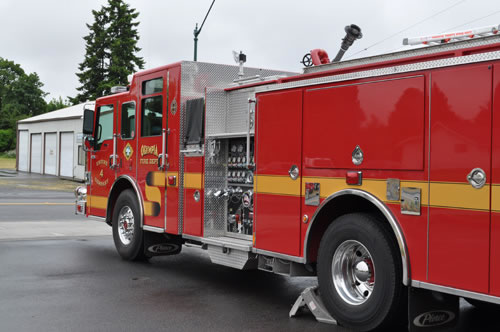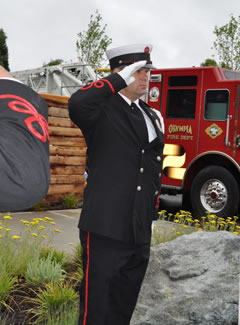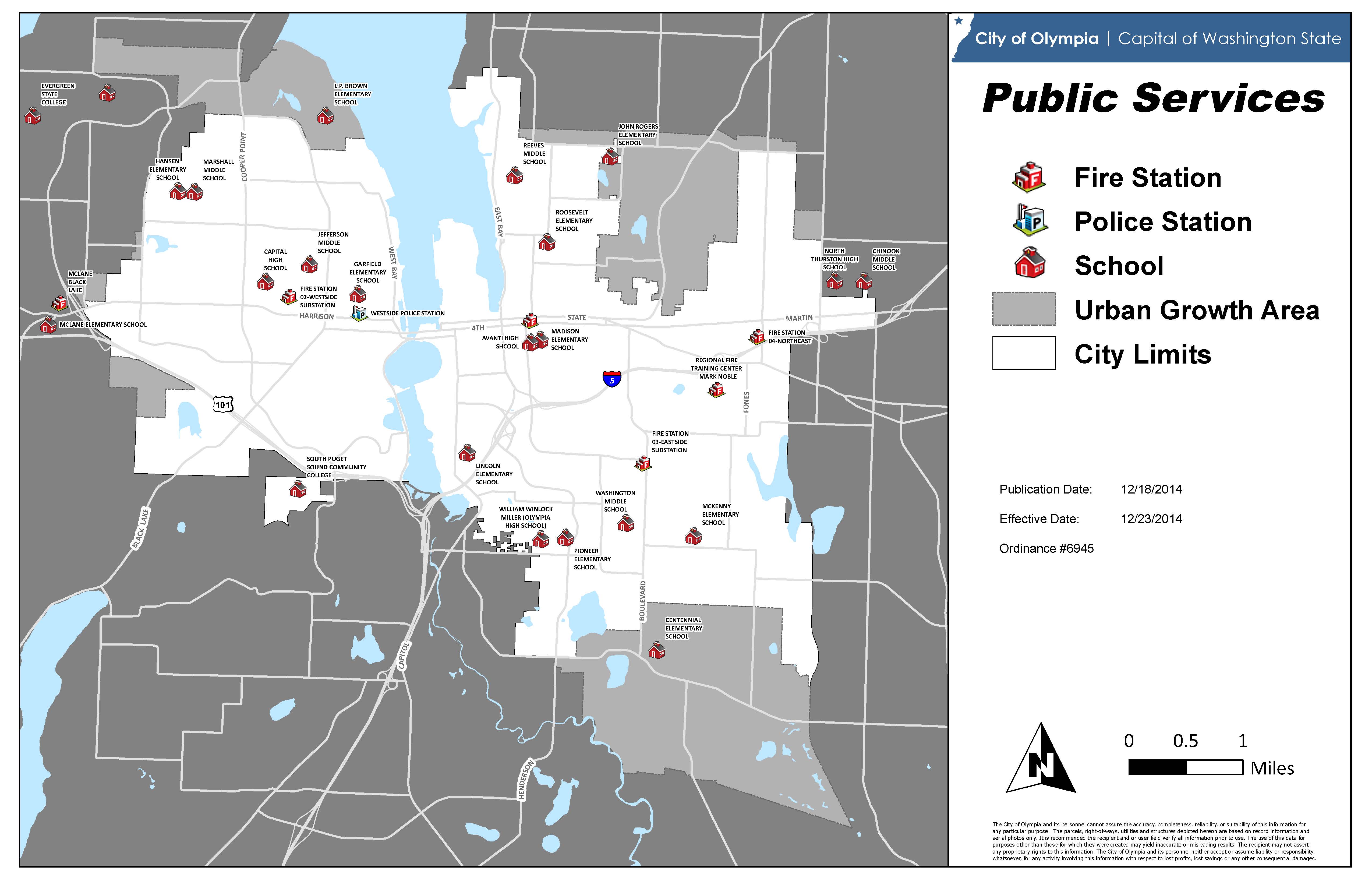Public Services Revised 11/21

Olympia Fire Department ladder truck during a training exercise
What Olympia Values:
Olympia residents value the protection our police, fire, and emergency medical services provide. They also support codes that enforce the City’s efforts to maintain neighborhood quality, adequate and affordable housing for all residents, community gathering places, and recreational centers.
Our Vision for the Future:
Responsive services and affordable housing for all.
Read more in the Community Values and Vision chapter.
Introduction
A stable community requires only that minimum needs are met for food, shelter, and safety. But for a community to thrive, it must also focus its public services on healthy and educated children, social service needs, responsive public safety systems, and strong neighborhoods. If we are to achieve these goals in Olympia, the City will continue to develop its meaningful partnerships with non-profits, neighborhoods, and regional governments.

Olympia youth eat together at a community food event.
Schools Shape Minds and Neighborhoods
Schools are centers of learning for our children, and their health and vitality can affect the health and vitality of the surrounding neighborhood. While the City doesn’t manage schools, it can help ensure the safety of children and work on facility planning with the school districts. In fact, this Comprehensive Plan must identify potential sites for future schools, as they are "lands needed for public purposes."
Olympia is served by Olympia School District No. 111, and a small portion is served by North Thurston School District No. 3. We are also fortunate to have opportunities for continuing education at South Puget Sound Community College, St. Martin’s University, and The Evergreen State College.
Goals and Policies
PS1.1Include the needs of schools, such as pedestrian safety and a quiet environment, when making land-use decisions for nearby areas.
PS1.2Build schools in central locations within areas they serve and on sites that will allow children to walk safely to school.
PS1.3Locate schools on (or near) a neighborhood collector street to minimize the impact of school bus and other traffic on the surrounding neighborhoods.
PS1.4Link new residential developments to school capacity.
PS1.5Coordinate with school officials when planning and prioritizing sites for future schools and historic preservation efforts.
PS2.1Encourage school districts to retain their existing sites, as the schools are critical to maintaining a strong and healthy neighborhood.
PS2.2Promote sharing school facilities for neighborhood parks, recreation, and open space.
PS2.3Support safe walking and bicycling routes for students.
Affordable Housing for All
Adequate and affordable housing is critical to a healthy community. It must be located near jobs and services or on bus routes. It also must be safe and well-maintained.
The City addresses housing needs for our most vulnerable community members through its Consolidated Plan, which is updated every three years. The Consolidated Plan identifies Olympia’s priority housing, shelter, social service, economic development and public facility needs. The City works with other jurisdictions, private industry and nonprofit organizations to find solutions to low-income housing needs.
Goals and Policies
PS3.1Promote a variety of residential densities and housing types so that housing can be available in a broad range of costs.
PS3.2Encourage preservation of existing houses.
PS3.3Take steps to ensure housing will be available to all income levels based on projected community needs.
PS4.1Support efforts to preserve the historic features or character of historic properties in City housing rehabilitation programs.
PS4.2Provide assistance and incentives to help low-income residents rehabilitate properties they cannot afford to maintain.
Special needs populations, such as people with developmental disabilities, the homeless, the frail elderly, and others who have difficulty securing housing, have adequate, safe, and affordable housing.
PS5.1Disperse housing for low-income, moderate-income, and special-needs residents throughout Olympia and its Urban Growth Area, and discourage concentration of such housing in any one geographic area.
PS5.2Support the Fair Share Housing allocation process and work with other jurisdictions to monitor progress toward achieving agreed upon goals.
PS5.3Evaluate the possibility of providing density bonuses to builders who provide low-income housing in market-rate developments, and of tying the bonus to affordability.
PS5.4Encourage new housing on transportation arterials and in areas near public transportation hubs.
PS5.5Encourage self-help housing efforts in which people earn home equity in exchange for renovation or construction work, such as "sweat equity" volunteer programs.
PS5.6Retain existing subsidized housing.
Social Services Fulfill a Vital Need
There are many reasons why community members may sometimes need extra help. The loss of a job or a serious illness can leave many of our residents without the means to meet their basic needs. Currently, the social safety net in our community is made up of a network of religious and charitable organizations that partner with local government to provide services to vulnerable community members.
PS6.1Support non-profit and faith-based charitable organizations that provide funding and/or oversight for social service funding.
PS6.2Work with other local governments to provide financial support and oversight of social service funding.
PS6.3Support programs and projects that assist low-income people and those at risk of homelessness with public funding.
PS6.4Identify barriers to social service, shelter and housing resources for low-income people and those at risk of becoming homeless.
There is enough emergency housing, transitional housing, permanent housing with supportive services, and independent affordable housing.
PS7.1Encourage a strong network of emergency shelter resources for homeless and at-risk families with children, childless adults, unaccompanied youth, and victims of sexual and domestic violence.
PS7.2Take a regional approach with other jurisdictions so that support for a broad range of social services and resources, including shelter and housing, can be maximized.
PS7.3Encourage businesses, charitable non-profit organizations, and faith-based community organizations to provide shelter and housing services.
PS7.4Support coordinated service delivery models to maximize the best use of public, charitable, and privately-funded shelter and housing resources.
PS7.5Support best practices that reflect current standards of care, and incorporate emerging models that optimize the use of public and charitable resources.
PS7.6Encourage shelter and housing providers and programs to locate in the greater Olympia area, or near transportation arterial hubs, so residents can easily access them.
PS7.7Work toward making the community more aware of homelessness in Olympia and how it can be prevented as a way to encourage charitable support and involve community members.
PS7.8Use data to continually assess the community’s need for shelter and housing and who it is serving. Use this data to continually improve these services.
PS7.9Revise policies that limit or prevent the community from providing shelter and housing resources.
PS7.10Coordinate land use, housing, transportation, and capital facility planning to support all aspects of shelter and housing resources, including emergency shelter, transitional housing, permanent housing with supportive services, and low-income housing.
PS7.11Integrate group homes into all residential areas of the community. Set zoning standards to ensure group home sizes (number of residents and staff) are compatible with allowed densities and that transportation and other services are available.
PS7.12Evaluate regulations so the City can be more flexible in locating shelters and increasing capacity.
PS8.1Continue to fund the repair and rehabilitation of single-family and multi-family housing using federal, state, and local funding sources.
PS8.2Support applications by the Housing Authority of Thurston County and other non-profit housing developers to construct or purchase existing units for low-rent public housing.
PS8.3Support applications from eligible non-profits to federal and state funding sources to build new, or rehabilitate existing housing to meet low-income housing needs.
PS8.4Encourage and provide technical assistance to private developers and non-profits applying for below-market-rate state or federal loans to construct or rehabilitate low-income, multifamily rental housing.
PS8.5When Community Development Block Grant or Housing and Urban Development-funded buildings are at risk of being converted to market-rate status, inform the tenants of any purchase and relocation options available. When possible, help the Housing Authority of Thurston County and non-profit organizations buy such housing.
PS8.6Enforce policies* that provide financial and relocation help to people who are displaced from their homes as a result of construction and development projects using federal funds.
*(Per section 104(d) of the Housing and Community Development Act of 1974 as amended, requiring the replacement of low- and moderate-income housing units that are demolished or converted to another use, in connection with a Community Development Block Grant project.)
PS9.1Continue to support projects funded by low-income tax credits and revenue bonds.
PS9.2Investigate and support appropriate multi-jurisdictional support for the Housing Authority of Thurston County bond sales.
PS9.3Promote partnerships between public and private non-profit organizations to increase housing and home ownership opportunities for people with special needs, and for low- and moderate-income households.
PS9.4Continue to encourage development of single-room occupancy units downtown, along urban corridors, and in other areas where high-density housing is permitted. This could include encouraging alliances between public, private, and nonprofit organizations.
PS9.5Evaluate the possibility of supporting a program that would allow low-income tenants of manufactured home parks to jointly purchase and renovate permanent sites for their manufactured homes. Consider funding programs to subsidize the interest rates, loan origination fees, and/or other costs of acquiring the land.
PS9.6Help low-income and special needs residents find ways to purchase housing, such as shared or limited-equity housing, lease-purchase options, co-housing, land trusts, and cooperatives.
PS9.7Work with jurisdictional partners through the county-wide Home Consortium, to fund affordable housing projects that serve low- and very low-income residents.
PS9.8Continue to administer the Housing Tax Credit program to develop both market-rate and low-income housing.
PS9.9Support non-profit and faith-based organizations in their efforts to provide emergency homeless shelters.
Code Enforcement Promotes Neighborhood Livability
Code Enforcement is a City program that allows community members and others to report violations of city code relating to health, safety, and welfare on private property. The program will investigate, for example, complaints about noise, trash, graffiti, signs, abandoned vehicles, overgrown noxious weeds, dangerous buildings, and encampments. As our communities grow, age, and become more dense, the program is becoming increasingly important to maintaining public safety and our high quality of life. The City expects that Code Enforcement will be collaborating even further in the future with Olympia’s Police, Fire, Public Works, Building, and Legal Departments as well as with neighborhood associations, not-for-profit organizations, businesses, and regional government agencies, such as Thurston County Animal Control.
Goals and Policies
PS10.1Direct efforts toward compliance first and penalties only when necessary.
PS10.2Reduce the amount of time community members are allowed to achieve compliance.
PS11.1Educate neighborhoods about code enforcement and other City services, and how they can best interact with them.
PS11.2Communicate regularly with neighborhoods.
PS12.1Provide community members who submit complaints with timely information on current code enforcement activities.
PS12.2Monitor and regularly report on how the program’s enforcement practices are working, so they can be improved or refined, if needed.
PS12.3Communicate with those who submit complaints and alleged violators in a predictable and timely manner.
Fire Services Prevent Harm to People and Property

An Olympia Fire Department vehicle.
The Olympia Fire Department is an organization of highly trained and prepared professionals who use the best technology available to protect the community and themselves.
The City’s Fire Department is also a part of the Thurston County Medic One System, whose paramedics and fire fighters can respond to injured people within six minutes of an alarm. Normally, Olympia’s fire fighters respond just ahead of the paramedic unit then continue to assist. But they also can respond to basic life support calls on their own.
The department’s approach to fire prevention and protection is in the Master Plan for Fire Protection which identifies the challenges facing the City and recommends specific solutions.

A City of Olympia fire fighter salutes in his formal uniform.
Goals and Policies
The community has a high level of fire protection, emergency medical services and disaster management services, equal to or exceeding the industry standard.
PS13.1Continue to manage fire protection functions, paramedic services, and City emergency services by planning, organizing, directing, and controlling the resources available.
PS13.2Continue to provide a highly skilled and adequately staffed fire fighting force to respond to fire, medical, and hazardous material emergencies, and to protect life and property.
PS13.3Continue to provide fire prevention and inspection services to minimize damage from fires.
PS13.4Continue to provide paramedic and basic life support care to the City of Olympia, as part of the Thurston County Medic One System.
PS13.5Upgrade the fire flow capacity of Olympia’s water system where needed to meet current safety standards.
PS13.6Model best practices in the local fire service community in areas like fire fighter safety, command practices, training and equipment maintenance.
PS13.7Coordinate the City’s preparation, mitigation, response and recovery to disasters through an all-hazard Emergency Management program that includes planning for major catastrophic events.
PS13.8Continue to serve as the coordinating agency for post-disaster recovery through the coordination of disaster cost recovery, and the facilitation of our community’s short- and long-term recovery goals and objectives.
PS13.9Educate community members on how to sustain their households without outside assistance for a minimum of 72 hours during an emergency event, and that some events, such as a severe earthquake, may require them to sustain themselves for five to ten days or more.
PS13.10Address the severe and extended impacts of a Cascadia Subduction Zone earthquake in the City’s emergency response plans and preparations.
PS13.11Continue to gather best available information on the impact a Cascadia Subduction Zone earthquake would have on the community, including the potential magnitude, impacts of vertical movements, and tsunamis.
Police Services Promote Public Safety
Public safety is key to our high quality of life. Our most beautiful neighborhoods, streets, and parks would not be desirable if there was always the threat of a crime. We cannot consider our streets to be walkable if people do not feel safe.
There are many ways to deliver police services. Every police organization has an individual "personality." It is shaped by the community’s values and expectations, the personal characteristics of its leaders, geography, demographics, and cultural heritage.
The City Council is ultimately responsible for providing the leadership needed to ensure a high quality of policing services. In Olympia, community members tend to be very involved in local government, and leadership comes from them as well.
Goals and Policies
Police services are delivered in a manner consistent with the values of the community members of Olympia.
PS14.1Deliver police services in a professional, timely, objective, and impartial manner.
PS14.2Understand and respect the diversity of our community. Strive to reflect that diversity in the composition of the Police Department.
PS14.3Interact respectfully with everyone in the community to earn their respect, using force only when needed. All levels of the agency must display the humility, cordiality, and courtesy needed to help community members see themselves as allies of their police force.
PS14.4Encourage a spirit of cooperation that balances the collective interests of all community members with the personal rights of individuals.
PS14.5Maintain a departmental environment that is open, accessible, responsive, and seeks feedback in a way that is consistent with the small-town feeling of the community.
PS14.6Provide strong and effective responses to serious criminal behavior, and use discretion and alternative sanctions for minor offenses.
PS15.1Form interdisciplinary partnerships with individuals and groups in the community to address policing issues.
PS15.2Involve community members as we look for ways to reduce repeat crimes, and use education to prevent crime.
PS15.3Emphasize the need for our police force to have positive, day-to-day interaction with the public that encourages collaboration on problem-solving, rather than responding only to crises. Regular contact between the police and community members helps strengthen working relationships and makes policing more effective.
Police services are provided in a manner consistent with Olympia’s values and that is cost-effective.
PS16.1Provide a high quality of service in the traditional police agency functions.
PS16.2Develop alternative ways to respond to calls for service when sworn officers are not required. This will free-up more time for our officers to develop strategies for preventing crime in our community.
PS16.3Whenever possible, make full use of non-sworn employees, volunteers, and referrals to other agencies so the City can respond to service requests cost-effectively.
PS16.4Focus on the quality of service provided to community members with non-emergency calls, rather than the speed of response.
PS16.5Use satellite stations and regular patrol beats to improve community member access to, and interaction with, the Police Department.
PS16.6Measure the Department’s level of service not by inputs (such as officers per capita), but by outcomes such as problems eliminated and community member satisfaction with the quality of officer interaction.
PS16.7Regularly track how police workloads are generated and find ways to reduce them, or allocate work more efficiently, both in and outside the Police Department. External entities which generate police workload should share responsibility for providing ways to manage it.
PS16.8Use technology to improve the City’s efficiency at completing necessary but time-consuming activities, such as report filing, data management, communication, and administrative tasks.
PS16.9Use data management technology to improve access to information, both for police personnel and community members.
PS16.10Provide specialized police units and services important to maintaining Olympia’s quality of life.
PS17.1Enlist the support of other public agencies and community service groups to help solve policing problems, and to evaluate the effectiveness of police services.
PS17.2Ensure regular communication and cooperation between the Police Department and other City departments, at both the managerial and line levels.
PS17.3Maximize the City’s efforts to recruit community volunteers and use them effectively.
PS17.4Communicate with Olympia’s diverse population to seek input on how best to meet their needs.
The effectiveness of Olympia’s police services is maximized by communicating openly and by being accessible and responsive to feedback.
PS18.1Communicate with the public on a regular basis to gain public understanding and consensus on the community’s policing needs.
PS18.2Seek opportunities to inform the public of Police Department programs and activities.
PS18.3Communicate with the community and the media about incidents on a timely basis.
PS18.4Provide open and accessible ways for the public to receive information about incidents.
PS18.5Provide both police personnel and the public with clearly articulated Police Department values that provide a clear sense of the City’s focus and direction.
PS18.6Ensure that the Police Department, and particularly the Chief, is active and visible in City government and in the community.
The effectiveness of Olympia’s police services is maximized by collaborating with other service providers.
PS19.1Work with social service providers to explore potential mutual strategies to address social problems.
PS19.2Build good working relationships with other agencies and social service providers, identifying divisions of responsibility and ways to cooperate effectively.
PS19.3Avoid using jails and the criminal justice system to address non-criminal social problems, whenever possible. Work with the courts to find alternatives to imprisonment, such as dispute resolution, substance abuse treatment, and other strategies that address underlying problems.
PS19.4Take steps to improve cooperation and communication among police, prosecutors, defenders, judges, and corrections agencies. Work with them on process improvements that will improve the effectiveness of our criminal justice system.
PS19.5Combine resources with other law enforcement agencies when a joint approach to law enforcement and crime prevention makes sense, such as central dispatch, drug enforcement, and SWAT teams.
PS19.6Look for creative ways to build relationships with private security firms, Animal Control, and other organizations, so they can help extend the capability of our Police Department.
PS19.7Build relationships with other police agencies to gain from their experiences and expertise.
PS20.1Ensure that Olympia’s accountability system includes accessibility, integrity, legitimacy, learning, and reasonable cost.
PS20.2Ensure that Olympia’s accountability system meets the interests of the City Council, City Manager, Police Department management, affected labor unions and the community in collaboratively providing accountability and support systems (like training, counseling, and feedback) that meet the policies of the Comprehensive Plan.
PS21.1Use energy-efficient designs and environmentally responsible materials and techniques in City facilities and construction projects. Work to reduce energy usage in existing City facilities.
PS21.2Use the City’s purchasing power to support sustainable business and manufacturing practices, including support for businesses that provide living-wage jobs.
PS21.3Support local businesses by buying locally whenever possible.

For More Information
• Thurston Regional Transportation Plan
• Community Development Block Grant Consolidated Plan
• Master Plan for Fire Protection


